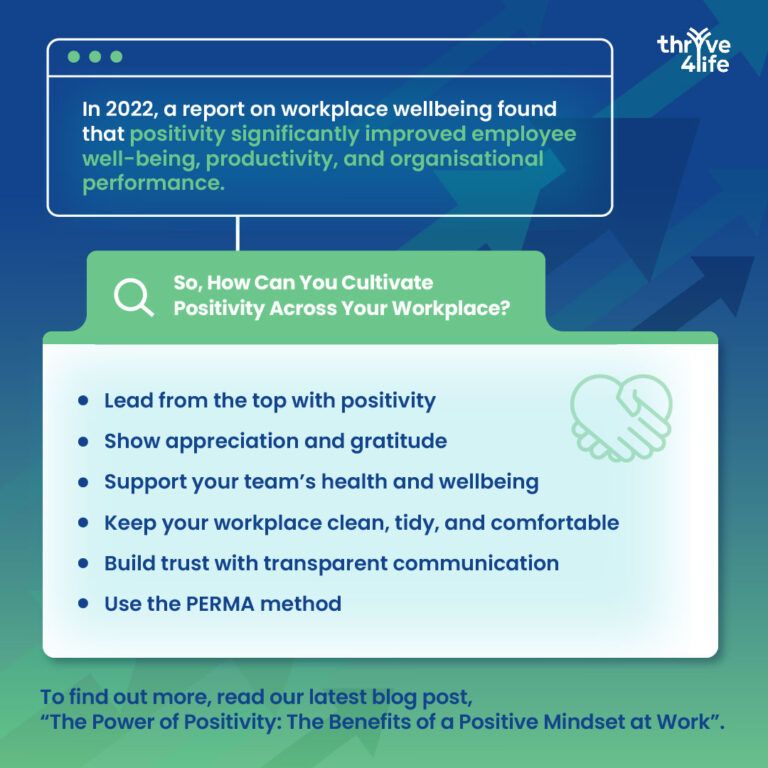Looking on the bright side might be perceived as a naïve way to deal with workplace challenges. When things go wrong, telling your team members to ‘stay positive’ might gain a few eye rolls (or equivalent thoughts!). However, positivity actually plays a huge role in productivity and success. A report on workplace wellbeing carried out in 2022 found that positivity had a significant impact on employee well-being, productivity, and organisational performance.

These findings emphasise the fact that a positive mindset at work is scientifically proven to be vital for improving employee well-being and productivity levels. Research shows that seeing the world in a more positive light can help us manage our stress levels and significantly impact our overall health. Changing our outlook to a more positive one shapes how we view the world around us and, therefore, how we approach challenges.
Positivity creates a more robust, resilient, and unified workforce. So, are you prioritising it in your life, as well as amongst your team?
What Does it Mean to Adopt a Positive Mindset?
Let’s be clear: positive thinking doesn’t mean ignoring life’s difficult situations; it means approaching unpleasantness or challenges more productively, by shifting our focus towards the optimistic. To do this, you should actively look for the brighter moments of life, hope for and imagine good outcomes, and view challenges as opportunities.
Having a positive mindset can change not only your outlook on life but also the contributions and wellbeing of yourself and those around you in your workplace. It’s an incredibly productive practice, enabling our perception and response to situations that test us to be turned on its head and viewed as an opportunity for growth.
How You Can Personally Benefit from a Positive Mindset
Optimism is a key factor in our physical health, mental health, job satisfaction, and overall quality of life. The benefits of feeling more positive include:
1. Higher levels of serotonin which positively impact our mental health
Optimism stimulates the production of serotonin, metaphorically flipping the happy switch inside our brains. This lessens our susceptibility to stress, anxiety, depression, and other mental health issues. Negative thinking shows up physically, too, with headaches and fatigue in the short term but also more serious issues like heart disease in the long term. By approaching your life with more optimism, you could seriously improve how you feel on a day-to-day basis.
2. Physical health
Optimism is linked to lower blood pressure, stronger immune responses, and a reduced risk of cardiovascular diseases. Having exemplary physical health will make you feel happier, healthier, and ready to tackle whatever life throws at you.
3. Optimism lends itself to a higher sense of wellbeing.
Individuals are more likely to practise healthy habits, have an excellent and stable work-life balance, build and maintain strong relationships, and overall have a better quality of life across the different pillars of wellbeing.
Let’s Take a Closer Look at Those Health Benefits
- Longer life
- Lower risk of depression
- Lower levels of pain and stress
- Higher resistance to illness
- Better cardiovascular health and reduced risk of death from cardiovascular diseases and stroke
- Reduced risk of fatality from cancer, infections, and respiratory conditions
- Better coping skills during hardship
How Could Promoting a Positive Mindset Benefit Your Organisation?
Positive thinking can significantly impact job performance – it will always have ripple effects on productivity and working environments. Just one person’s optimism can influence an entire workforce, creating positive change.
1. Increased productivity levels.
Positive thinkers tend to take pride in their work and want to grow from the challenges they face. This lends itself to improved efficiency and higher productivity, as positivity fuels better performance.
2. Problems become opportunities
Problem-solving becomes an opportunity for innovation and creativity when employees view it as a chance for growth. This drives everyone forward in their work and the company in its progression.
3. Optimistic individuals find purpose in their work
This leads to a higher job satisfaction level, increased motivation, and a drive to grow within the workplace.
4. Positive working environments promote healthy teamwork and collaboration
Being positive is also infectious, so rather than building a team that deals with things alone, optimism can help bring people together – especially useful when confronting challenges.
5. Resilience in the face of adversity
Positive people are better at managing stress, bounce back quickly after setbacks, and are adaptable to change. These qualities help contribute to a stable and resilient workforce.
6. Absenteeism/presenteeism/leaveism/pleasanteeism
Working within a positive environment makes employees want to come in and do their best. Having a safe, supportive atmosphere also means your team will feel like they can be honest and transparent, voicing criticism as well as positivity and thus lessening the risk of issues like pleasanteeism.
7. Renowned reputation and attraction
When employees are happy where they work, they are happy to spread the word. This creates a good company reputation, potentially attracting more talent.
8. Psychological safety
Working in a positive environment can help you and your team feel psychologically safe – feeling comfortable about taking risks, raising concerns, offering constructive criticism, and asking questions without fear of negative consequences, backlash, or judgement. Only when this is achieved will teamwork flourish and your workplace grow.
9. Improved engagement
Positive people are a joy to work with. Having an optimistic workforce will boost engagement and encourage more cohesive teamwork.
Toxic Positivity
This is when “we have to be overly happy, overly excited, [or] overly positive just to be seen on the same level as everyone else,” says Dr M Nickleson Battle Jr, a licensed therapist and president of the National Association of Black Counsellors. “We can’t point out the fact that something bad could possibly happen because now we’re being negative.” In a nutshell, toxic positivity drowns out anything other than the good. To make positive thinking constructive, it’s important to find the balance between acknowledging challenges and issues while still viewing them with a glass-half-full outlook.
How to Cultivate Positivity at Work
Beyond boosting morale, cultivating positivity in the workplace is one of the best things you can do to improve your health and wellbeing strategy and your company’s overall culture. Your efforts to promote positivity should seek to improve employee wellbeing, resulting in higher productivity and a healthy, balanced workplace culture. Here are some strategies to try:
- Positive leadership. Leaders and managers are very influential in their teams. When you choose to demonstrate positive behaviour, it sets an exemplary tone for the rest of the workforce. This might look like finding solutions rather than digging for problems, acknowledging your team’s efforts, and targeting growth, not perfection.
- Appreciation of efforts. Recognising your employees’ work helps them feel seen and successful in their work. This will increase their motivation, encourage them to perform better, and help them stay positive while working.
- Creating a supportive environment. Having and promoting resources that help with physical and mental wellbeing helps employees feel valued. This reduces issues like stress and burnout among employees, too.
- A comfortable workplace. Having a dirty, loud, or messy work environment will take its toll on employee wellbeing. Ensuring the workplace is clean, tidy, and comfortable will contribute more than you think to employee satisfaction.
- Cultivating trust through communication. Encouraging transparent communication helps employees feel responsible and valued. It will enable them to voice their opinions and concerns, which builds trust amongst a team and allows a workforce to keep improving. Consider involving your staff in decision-making, and ensure regular one-to-one sessions are held.
- The PERMA method. A model developed by Martin Seligman in 2011, PERMA describes the 5 essential components of wellbeing which can be used in the workplace to promote growth mindsets which create a happy and engaged team:
- Positive emotions: joy, contentment, and satisfaction.
- Engagement: being fully absorbed in an activity.
- Relationships: having strong social connections.
- Meaning: having a sense of purpose and direction.
- Accomplishment: having a sense of achievement.
Improving Positivity Across Your Team
Knowing where to start when creating a more positive workplace can be tricky, so let us do the work for you!
- Thrive4Life’s Mental Health Training services focus on improving knowledge and understanding all the issues employees may face and how to solve them.
- Our Wellbeing Champion Training course educates delegates on how they can promote a physically and mentally healthier work environment.
- If you don’t know where to start, use our Wellbeing Consultancy services to identify your company’s specific health and wellbeing needs. We can then help you build a health and wellbeing strategy catering to your organisation-specific needs
A positive mindset isn’t created overnight on either an individual or a team-wide level. It’s about creating a new habit and rewiring your brain to look for the good in situations and challenges. When your state of mind is more positive, you become able to handle everyday stress more constructively. Although positivity can’t always change what happens to you, it’ll help you view life’s ups and downs in a new light, prioritising growth, learning, and optimism. You may just find that positivity is the one thing you need to brighten up your work days.
Further Reading
- Emotional intelligence is key when trying to boost positivity in the workplace. Learn about the importance of emotional awareness at work here.
- Positivity starts with gratitude. Learn about the importance of practising gratitude every day here.
- Read about why healthy workforces are good for business here.










